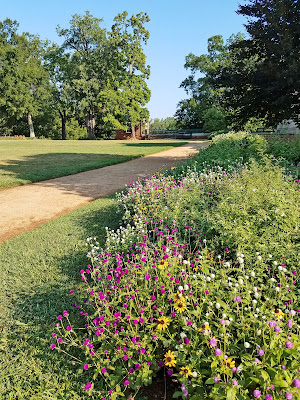Thursday, August 5, 2021
*About March 1806, several large crates and boxes arrived at Monticello, the home of President Thomas Jefferson. Jefferson wanted to exhibit the specimens and artifacts in his entrance hall. There were animal skins, horns, and antlers of elk, deer, and pronghorn antelopes. Also indigenous buffalo robes, beaded leggings, an otter skin bag, earthenware pots, clay pipes, and bows and arrows.*
 |
Thomas Jefferson greets you at the top
of the stairs where you catch a shuttlebus
to the top of the "little mountain" |
 |
Monticello (1769-1809) is Italian for little mountain, and
was designed by Thomas Jefferson, then re-designed in 1794 |
 |
| In the center is the otter skin bag (KSS) |
 |
| In the center is a buffalo hide painted with a battle scene |
 |
| On the right is a Peace Medal showing the reverse side (KSS) |
 |
The only original specimen from the Lewis and Clark
expedition is the set of elk antlers on the left |
 |
Fossil bones from Big Bone Lick,
but not the ones sent by Meriwether Lewis |
 |
Monticello library, where only a couple
shelves of books (covered by plexiglass)
actually belonged to Thomas Jefferson;
the rest are titles he once owned |
 |
On the table in the office is a polygraph
duplicating device, which is how Thomas
Jefferson made copies
of all his correspondence to keep |
 |
One of Jefferson's space-saving ideas
was to put the beds in wall niches,
as seen here in his own bedroom |
 |
The boots (no left or right differentiation)
are said to have belonged to Thomas Jefferson |
 |
| Thomas Jefferson's own chess pieces, in the parlor |
 |
| A vacuum pump as a conversation piece |
 |
| Dining room wine dumbwaiter |
 |
Jefferson liked his guests to dine in small groups of
up to four people to encourage conversation |
 |
To minimize interruptions during a meal,
meals were placed on this revolving door
and transferred to the small trolley of
shelves seen in the photo above |
 |
Guest room frequently used by James and Dolley Madison,
who lived 30 miles or a day's horse and carriage ride away |
While Thomas Jefferson is the primary author of the Declaration of Independence, it is James Madison who is considered the Father of the United States Constitution. Jefferson was serving as the United States Minister to France at the time the Constitution was written, but he corresponded regularly with Madison and several others involved. One interesting idea that Jefferson offered, was that the Constitution should expire every 19 years (the length of one generation) and be re-written or renewed according to the needs of future generations, because "the earth belongs to the living, not the dead."
 |
With many guests staying overnight, some were
accommodated in hallways on a convertible couch,
seen here, that folded flat into a bed |
In his retirement, Thomas Jefferson had his oldest daughter and family live with him, so that his daughter could be mistress of the house, or keeper of the keys. Martha and her husband, Thomas Mann Randolph, Jr (former governor of Virginia), and their eleven surviving children filled the house.
 |
| A copy of William Clark's map in the Boys' Room |
 |
| The Dome Room (KSS) |
The doors opposite the dome room's entry doors were there to maintain symmetry, and only led to an attic of the entrance pediment.
 |
| However, the granddaughters made the attic their secret space |
 |
The doors seem to have faux panels
outlined with gold-painted lines (KSS) |
 |
| The nursery with a gray-painted crib said to be original |
 |
Martha's bedroom; she finally convinced her father
(when she was in her 50s) to allow her to have a real bed,
and turn the bed-niche into a closet |
 |
The windows are low on Martha's bedroom, so that
the East side of Monticello looks like a one-story building |
 |
| Specialized beer cellar |
 |
| The kitchen was in one end of the cellars (KSS) |
 |
Rooms to one side of the cellars were for the enslaved
people working in the house, such as Sally Hemings |
Times have changed, and historians are doing their best to be inclusive in telling the stories based on what they have learned from writings and oral histories. For one, they are now using the term enslaved people instead of slaves. Next, they are recognizing all of Thomas Jefferson's children. He and his wife had six children, of which two girls lived to adulthood. Later, Jefferson and Sally Hemings (who was a half-sister to Jefferson's wife) also had six children, of which three boys and one girl survived to adulthood.
Descendants of the enslaved people of Monticello are now involved in telling their stories and in the management of Monticello that was home to their people.
 |
| Other enslaved persons would have a cabin |
 |
| Interior of the cabin |
 |
| Stables |
 |
| Part of the extensive vegetable garden |
 |
Textile building where Thomas Jefferson stated he made
2,000 yards of cloth per year for his family, saving him
from having to purchase cloth from England; Excuse me!
- his enslaved women, children, and invalids who could
do little else made all that cloth! |
 |
| Inside the textile building |
 |
Mulberry Row along which the shops
of his skilled workers (free whites, free Blacks,
indentured servants, and enslaved people)
were located, including blacksmiths, tinsmiths,
carpenters and joiners, and gardeners |
 |
| Ruins of the joinery shop |
 |
| Jefferson Family Cemetery |
 |
| Grave marker for Thomas Jefferson |
Next: James Monroe's Highland.












































No comments:
Post a Comment